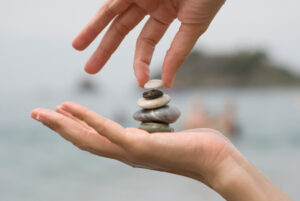“If the only prayer you say in your life is ‘thank you,’ that would suffice.” – Meister Eckhart
Gratitude means thankfulness, counting your blessings, noticing simple pleasures, and acknowledging everything that you receive. It means learning to live your life as if everything were a miracle, and being aware on a continuous basis of how much you’ve been given. Gratitude shifts your focus from what your life lacks to the abundance that is already present. In addition, behavioral and psychological research has shown the surprising life improvements that can stem from the practice of gratitude. Giving thanks makes people happier and more resilient, it strengthens relationships, it improves health, and it reduces stress.
Research Shows Gratitude Heightens Quality of Life
Two psychologists, Michael McCollough of Southern Methodist University in Dallas, Texas, and Robert Emmons of the University of California at Davis, wrote an article about an experiment they conducted on gratitude and its impact on well-being. The study split several hundred people into three different groups and all of the participants were asked to keep daily diaries. The first group kept a diary of the events that occurred during the day without being told specifically to write about either good or bad things; the second group was told to record their unpleasant experiences; and the last group was instructed to make a daily list of things for which they were grateful. The results of the study indicated that daily gratitude exercises resulted in higher reported levels of alertness, enthusiasm, determination, optimism, and energy. In addition, those in the gratitude group experienced less depression and stress, were more likely to help others, exercised more regularly, and made greater progress toward achieving personal goals.
Dr. Emmons – who has been studying gratitude for almost ten years and is considered by many to be the world’s leading authority on gratitude – is author of the book, “Thanks!: How the New Science of Gratitude Can Make You Happier”. The information in this book is based on research involving thousands of people conducted by a number of different researchers around the world. One of the things these studies show is that practicing gratitude can increase happiness levels by around 25%. This is significant, among other things, because just as there’s a certain weight that feels natural to your body and which your body strives to maintain, your basic level of happiness is set at a predetermined point. If something bad happens to you during the day, your happiness can drop momentarily, but then it returns to its natural set-point. Likewise, if something positive happens to you, your level of happiness rises, and then it returns once again to your “happiness set-point”. A practice of gratitude raises your “happiness set-point” so you can remain at a higher level of happiness regardless of outside circumstances.
In addition, Dr. Emmons’ research shows that those who practice gratitude tend to be more creative, bounce back more quickly from adversity, have a stronger immune system, and have stronger social relationships than those who don’t practice gratitude. He further points out that “To say we feel grateful is not to say that everything in our lives is necessarily great. It just means we are aware of our blessings.”
Notice and Appreciate Each Day’s Gifts
People tend to take for granted the good that is already present in their lives. There’s a gratitude exercise that instructs that you should imagine losing some of the things that you take for granted, such as your home, your ability to see or hear, your ability to walk, or anything that currently gives you comfort. Then imagine getting each of these things back, one by one, and consider how grateful you would be for each and every one. In addition, you need to start finding joy in the small things instead of holding out for big achievements—such as getting the promotion, having a comfortable nest egg saved up, getting married, having the baby, and so on–before allowing yourself to feel gratitude and joy.
Another way to use giving thanks to appreciate life more fully is to use gratitude to help you put things in their proper perspective. When things don’t go your way, remember that every difficulty carries within it the seeds of an equal or greater benefit. In the face of adversity ask yourself: “What’s good about this?”, “What can I learn from this?”, and “How can I benefit from this?”
There are Many Ways to Practice Gratitude
A common method to develop the practice of gratitude is to keep a gratitude journal, a concept that was made famous by Sarah Ban Breathnach’s book “Simple Abundance Journal of Gratitude”. This exercise basically consists of writing down every day a list of three to ten things for which you are grateful; you can do this first thing in the morning or before going to bed at night. Another exercise you can try is to write a gratitude letter to a person who has exerted a positive influence in your life but whom you have not properly thanked. Some experts suggest that you set up a meeting with this person and read the letter to them face to face.
Last year millions of people took the challenge proposed by Will Bowen, a Kansas City minister, to go 21 days without complaining, criticizing, or gossiping. To help condition the participants to stop complaining, they each wore a purple No-Complaint wristband. Several authors in the self-improvement genre have suggested that people do something similar to help condition themselves to be constantly aware of the things in life that they’re grateful for.
A variation of the wristband concept is to create a gratitude charm bracelet, with either one meaningful charm or different charms representing the things you’re most grateful for. For example, you could have a charm shaped like a heart to symbolize your significant other, figurines to represent different family members, an apple to represent health, a dollar sign to symbolize abundance, a charm that represents your current profession or a future career, and maybe a charm that makes you laugh to represent humor and joy.
Conclusion
Once you become oriented toward looking for things to be grateful for, you will find that you begin to appreciate simple pleasures and things that you previously took for granted. Gratitude should not be just a reaction to getting what you want, but an all-the-time gratitude, the kind where you notice the little things and where you constantly look for the good even in unpleasant situations. Today, start bringing gratitude to your experiences, instead of waiting for a positive experience in order to feel grateful; in this way, you’ll be on your way toward becoming a master of gratitude.








